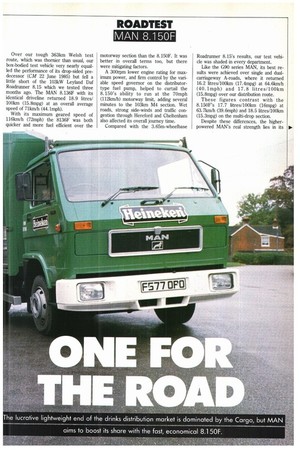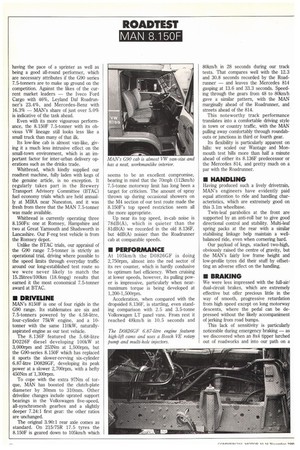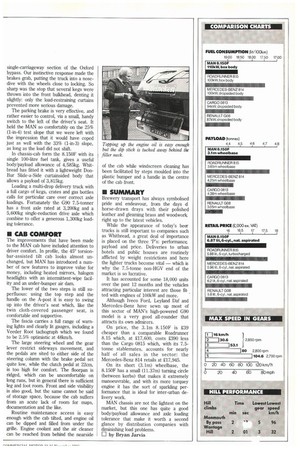• Compared with its predecessor, MAN's 150F 7.5-tonner is something of a wolf in a sheepskin.
Page 36

Page 37

Page 38

Page 39

If you've noticed an error in this article please click here to report it so we can fix it.
At first glance, its extra 10kW over the now obsolete 100kW 8.136F seems trivial, bearing in mind the continuing rise in engine outputs at the heavier end of MAN's truck range. The real changes — extremely lively acceleration and excellent fuel economy — are achieved through the use of a larger, slower-revving engine that punches out nearly 28% more torque and is 6.3% more fuel efficient.
Over our tough 363km Welsh test route, which was thornier than usual, our box-bodied test vehicle very nearly equalled the performance of its drop-sided predecessor (CM 22 June 1985) but fell a little short of the 103kW Leyland Daf Roadrwmer 8.15 which we tested three months ago. The MAN 8.136F with its identical driveline returned 18.9 litres/ 1001cm (15.8mpg) at an overall average speed of 711crn/h (44.1mph).
With its maximum geared speed of 116km/h (72mph) the 8136F was both quicker and more fuel efficient over the motorway section than the 8.150F. It was better in overall terms too, but there were mitigating factors.
A 300rpm lower engine rating for maximum power, and firm control by the variable speed governor on the distributortype fuel pump, helped to curtail the 8.150's ability to run at the 70mph (112km/h) motorway limit, adding several minutes to the 103Iun M4 section. Wet roads, strong side-winds and traffic congestion through Hereford and Cheltenham also affected its overall journey time.
Compared with the 3.65m-wheelbase Roadrunner 8.15's results, our test vehicle was shaded in every department.
Like the G90 series MAN, its best results were achieved over single and dualcarriageway A-roads, where it returned 16.2 litres/1001cm (17.4mpg) at 64.61cm/h (4 0.1mph) and 17.8 litres/100km (15.8mpg) over our distribution route.
These figures contrast with the 8.150F's 17.7 litres/100Icm (16mpg) at 63.71un/h (39.6mph) and 18.5 litres/1001cm (15.3mpg) on the multi-drop section.
Despite these differences, the higherpowered MAN's real strength lies in its having the pace of a sprinter as well as being a good all-round performer, which are necessary attributes if the G90 series 7.5-tonners are to make up ground on the competition. Against the likes of the current market leaders the Iveco Ford Cargo with 46%, Leyland Daf Roadrunner's 23.4%, and Mercedes-Benz with 16.3% MAN's share of just over 5.0% is indicative of the task ahead.
Even with its more vijgourous performance, the 8.150F 7.5-tonner with its obvious VW lineage still looks less like a small truck than many of that ilk.
Its low-line cab is almost van-like, giving it a much less intrusive effect on the small-town environment, which is an important factor for inter-urban delivery operations such as the drinks trade.
Whitbread, which kindly supplied our roadtest machine, fully laden with kegs of the genuine article, is no exception. It regularly takes part in the Brewery Transport Advisory Committee (BTAC) fuel economy trials which are held annually at MIRA near Nuneaton, and it was fresh from there that the MAN 7.5-tonner was made available.
Whitbread is currently operating three 8.150Fs: one at Romsey, Hampshire and two at Great Yarmouth and Shadsworth in Lancashire. Our F-reg test vehicle is from the Ramsey depot.
Unlike the BTAC trials, our appraisal of the G90 range 7.5-tanner is strictly an operational trial, driving where possible to the speed limits through everyday traffic around our long-established test route so we were never likely to match the 15.2litres/100km (18.6mpg) results that earned it the most economical 7. 5-tanner award at BTAC.
• DRIVELINE
MAN's 8150F is one of four rigids in the G90 range. Its stablemates are six and 7. 5-tanners powered by the 4.58-litre, four-cylinder 75kW engine, and a 10tonner with the same 110kW, naturallyaspirated engine as our test vehicle.
The 8.136F featured the 5.68-litre D0226F diesel developing 100kW at 3,000rpm and 253Nm at 1,500rpm, but the G90-series 8.150F which has replaced it sports the slower-revving six-cylinder 6.87-litre D0826GF, developing its peak power at a slower 2,700rpm, with a hefty 450Nm at-1,300rpm.
To cope with the extra 97Nm of torque, MAN has boosted the clutch-plate diameter by 30mm to 310mm. Other driveline changes include uprated support bearings in the Volkswagen five-speed, all-synchromesh gearbox and a slightly deeper 7.24:1 first gear: the other ratios are unchanged.
The original 3.90:1 rear axle comes as standard. On 215/75R 17.5 tyres the 8.150F' is geared down to 105kmih which seems to be an excellent compromise, bearing in mind that the 70mph (112km/h) 7.5-tonne motorway limit has long been a target for criticism. The amount of spray thrown up during occasional showers on the M4 section of our test route made the 8.150F's top speed restriction seem all the more appropriate.
Up near its top speed, in-cab noise is .78dB(A), which is quieter than the 81dB(A) we recorded in the old 8.136F, but 4dB(A) noisier than the Roadrunner cab at comparable speeds.
• PERFORMANCE
At 105km/h the D0826GF is doing 2,750rpm, almost into the red sector of its rev counter, which is hardly condusive to optimum fuel efficiency. When cruising at lower speeds, however, its pulling power is impressive, particularly when nearmaximum torque is being developed at 1,200-1,500rpm.
Acceleration, when compared with the dropsided 8.136F, is startling, even standing comparison with 2.5 and 3.5-tonne Volkswagen Li panel vans. From rest it reached 48km/h in 10.5 seconds and
801an/h in 28 seconds during our track tests. That compares well with the 12.3 and 30.8 seconds recorded by the Roadrunner and leaves the Mercedes 814 gasping at 13.6 and 33.3 seconds. Speeding through the gears from 48 to 80km/h gave a similar pattern, with the MAN marginally ahead of the Roadrunner, and streets ahead of the 814.
This noteworthy track performance translates into a comfortable driving style in town or country traffic, with the MAN pulling away comfortably through roundabouts or junctions in third or fourth gear.
Its flexibility is particularly apparent on hills: we scaled our Wantage and Monmouth test hills more than half a minute ahead of either its 8.136F predecessor or the Mercedes 814, and pretty much on a par with the Roadrunner.
• HANDLING
Having produced such a lively drivetrain, MAN's engineers have evidently paid equal attention to ride and handling characteristics, which are extremely good on this 3.1m wheelbase.
Twin-leaf parabolics at the front are supported by an anti-roll bar to give good directional control and stability. Multi-leaf spring packs at the rear with a similar stabilising linkage help maintain a wellbalanced ride, even when cornering hard.
Our payload of kegs, stacked two-high, obviously raised the centre of gravity, but the MAN's fairly low frame height and low-profile tyres did their stuff by offsetting an adverse effect on the handling.
• BRAKING
We were less impressed with the frill-air/ dual-circuit brakes, which are extremely effective but offer precious little in the way of smooth, progressive retardation from high speed except on long motorway descents, where the pedal can be depressed without the likely accompaniment of jerking from road bumps.
This lack of sensitivity is particularly noticeable during emergency braking as we discovered when an 8x4 tipper lurched out of roadworks and into our path on a single-carriageway section of the Oxford bypass. Our instinctive response made the brakes grab, putting the truck into a nosedive with the wheels close to locking. So sharp was the stop that several kegs were thrown into the front bulkhead, denting it slightly: only the load-restraining curtains prevented more serious damage.
The parking brake is very effective, and rather easier to control, via a small, handy switch to the left of the driver's seat. It held the MAN so comfortably on the 25% (1-in-4) test slope that we were left with the impression that it would have coped just as well with the 33% (1-in-3) slope, as long as the load did not shift.
In chassis-cab form the 8.150F with its single 100-litre fuel tank, gives a useful body/payload allowance of 4,585kg. Whitbread has fitted it with a lightweight DonBur Slide-a-Side curtainsided body that allows a payload of 3,815kg.
Loading a multi-drop delivery truck with a full cargo of kegs, crates and gas bottles calls for particular care over correct axle loadings. Fortunately the G90 7.5-tonner has a front axle rated at 3,200kg and a 5,600kg single-reduction drive axle which combine to offer a generous 1,300kg loading tolerance.
• CAB COMFORT
The improvements that have been made to the MAN cab have included attention to driver comfort. In profile, the 45° torsionbar-assisted tilt cab looks almost unchanged, but MAN has introduced a number of new features to improve value for money, including heated mirrors, halogen headlights with an intermittent-wipe facility and an under-bumper air dam.
The lower of the two steps is still superfluous: using the top step and the handle on the A-post it is easy to swing up into the driver's seat which, like the twin cloth-covered passenger seat, is comfortable and supportive.
The fascia carries a full range of warning lights and clearly lit gauges, including a Veeder Root tachograph which we found to be 2.5% optimistic at 481un/h.
The large steering wheel and the gear lever restrict sideways movement, and the pedals are sited to either side of the steering column with the brake pedal set quite low, while the clutch pedal at 22cm, is too high for comfort. The floorpan is ridged, which can be uncomfortable on long runs, but in general there is sufficient leg and foot room. Front and side visibility is also good, but the same cannot be said of storage space, because the cab suffers from an acute lack of room for maps, documentation and the like.
Routine maintenance access is easy enough with the cab tilted, and engine oil can be dipped and filled from under the grille. Engine coolant and the air cleaner can be reached from behind the nearside of the cab while windscreen cleaning has been facilitated by steps moulded into the plastic bumper and a handle in the centre of the cab front.
• SUMMARY
Brewery transport has always symbolised pride and endeavour, from the days cf horse-drawn drays with their polished leather and gleaming brass and woodwork right up to the latest vehicles.
While the appearance of today's beer trucks is still important to companies such as Whitbread, a great deal of importance is placed on the three 'P's: performance payload and price. Deliveries to urban hotels and public houses are routinely afflicted by weight restrictions and here the lighter trucks become vital — which is why the 7.5-tonne non-HGV end of the market is so lucrative.
It has accounted for some 18,000 units over the past 12 months and the vehicles attracting particular interest are those fitted with engines of 100kW and more.
Although Iveco Ford, Leyland Daf and Mercedes-Benz have sewn up most of this sector of MAN's high-powered G90 model is a very good all-rounder that attracts its own admirers.
On price, the 3.1m 8.150F is 239 cheaper than a comparable Roadrunner 8.15 which, at 217,600, costs 290 less than the Cargo 0815 which, with its 7.5tonne stablemates, accounts for nearly half of all sales in the sector: the Mercedes-Benz 814 retails at £17,945.
On its short (3.1m) wheelbase, the 8.150F has a small (11.37m) turning circle (between kerbs) that makes it extremely manoeuvrable, and with its more torquey engine it has the sort of sparkling performance that is ideal for inter-urban delivery work.
MAN chassis are not the lightest on the market, but this one has quite a good body/payload allowance and axle loading tolerance that make it worth a second glance by distribution companies with diminishing load problems. LI by Bryan Jarvis
















































